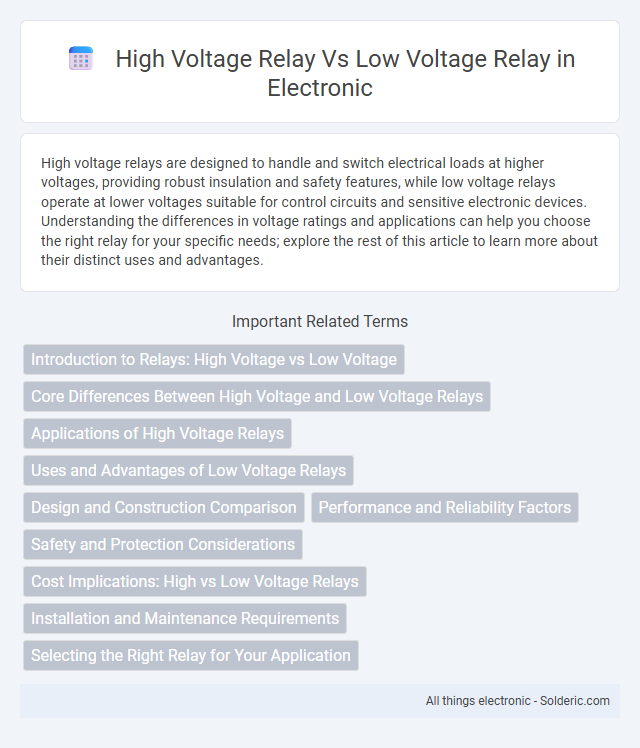High voltage relays are designed to handle and switch electrical loads at higher voltages, providing robust insulation and safety features, while low voltage relays operate at lower voltages suitable for control circuits and sensitive electronic devices. Understanding the differences in voltage ratings and applications can help you choose the right relay for your specific needs; explore the rest of this article to learn more about their distinct uses and advantages.
Comparison Table
| Feature | High Voltage Relay | Low Voltage Relay |
|---|---|---|
| Operating Voltage | Above 1000V | Below 1000V |
| Application | Power transmission, industrial equipment | Consumer electronics, control circuits |
| Contact Rating | High current and voltage handling | Low current and voltage handling |
| Insulation | Enhanced insulation to prevent arcing | Standard insulation |
| Size | Larger and robust | Compact and lightweight |
| Cost | Higher due to special materials | Lower |
| Safety Standards | Strict standards (IEC, UL) | Standard safety regulations |
Introduction to Relays: High Voltage vs Low Voltage
High voltage relays are designed to control circuits operating at voltages typically above 1000 volts, providing insulation and safety for industrial and power transmission applications. Low voltage relays function at voltages below 1000 volts and are commonly used in control panels, automation systems, and household appliances. Your choice between high voltage and low voltage relays depends on the specific voltage requirements and insulation standards of your electrical system.
Core Differences Between High Voltage and Low Voltage Relays
High voltage relays are designed to handle electrical loads typically above 1000 volts, making them suitable for industrial power systems and high-voltage equipment protection. Low voltage relays operate under 1000 volts, commonly used in control circuits and residential or commercial applications where lower voltage levels are safer and more manageable. Your choice between these relays will depend on the voltage rating requirements, insulation needs, and application environment to ensure optimal safety and functionality.
Applications of High Voltage Relays
High voltage relays are essential in power transmission and distribution systems where they control circuits with voltages exceeding 1,000 volts, ensuring safe operation in electrical substations and industrial equipment. These relays are vital in protecting transformers, circuit breakers, and high voltage switching devices from faults and overloads. Your electrical infrastructure benefits from high voltage relays by maintaining reliable performance in environments demanding robust voltage handling and rapid switching capabilities.
Uses and Advantages of Low Voltage Relays
Low voltage relays are commonly used in control circuits, automation systems, and low power applications due to their ability to operate safely at lower voltages, reducing the risk of electrical shock and equipment damage. Their advantages include faster switching times, compact size, and lower cost compared to high voltage relays, making them ideal for applications requiring precise control and energy efficiency. You benefit from improved reliability and ease of integration in sensitive electronic devices and industrial control panels when choosing low voltage relays.
Design and Construction Comparison
High voltage relays are designed with robust insulation materials, larger contact gaps, and reinforced arc quenching mechanisms to handle voltages typically above 1000 volts, ensuring safety and performance under high-stress conditions. Low voltage relays feature more compact designs, with smaller contacts and simpler insulation systems optimized for voltages below 1000 volts, allowing faster switching times and lower power consumption. The construction differences directly impact durability, size, and application suitability, with high voltage relays emphasizing electrical isolation and material strength, while low voltage relays prioritize efficiency and compactness.
Performance and Reliability Factors
High voltage relays are designed to handle voltages typically above 1,000 volts, offering superior insulation and contact materials that enhance performance under heavy electrical loads. Low voltage relays operate below this threshold and prioritize faster switching speeds and energy efficiency, making them suitable for control and automation tasks. Your choice between the two should consider the operational environment, switching frequency, insulation requirements, and expected electrical load to ensure optimal reliability and longevity.
Safety and Protection Considerations
High voltage relays are designed with enhanced insulation and isolation features to handle voltage levels typically above 1000V, minimizing the risk of electrical arcing and ensuring operator safety in industrial and power transmission settings. Low voltage relays operate at voltages below 1000V and incorporate protective mechanisms suited for control circuits and lighting systems, emphasizing fast response and overload protection. Safety considerations for both relay types include ensuring proper voltage rating compatibility, thermal stability, and compliance with industry standards like IEC 60947-4-1 to prevent equipment damage and electrical hazards.
Cost Implications: High vs Low Voltage Relays
High voltage relays generally incur higher costs due to their robust insulation materials and more rigorous safety standards required to handle greater electrical stress. Low voltage relays are typically more cost-effective, benefiting from simpler design and lower manufacturing complexity, making them suitable for residential and light industrial applications. Budget-conscious projects often favor low voltage relays for their affordability and ease of integration without compromising essential control functions.
Installation and Maintenance Requirements
High voltage relays require specialized installation procedures, including reinforced insulation and precise clearances to handle higher electrical stresses safely. Maintenance of high voltage relays involves thorough insulation testing and routine checks for contact wear due to arc erosion under higher loads. Low voltage relays are generally easier to install and maintain, with simpler wiring and less stringent safety protocols, making them more suitable for less complex electrical systems and your everyday applications.
Selecting the Right Relay for Your Application
Selecting the right relay for your application depends on the voltage requirements, current load, and environmental conditions. High voltage relays, typically rated above 1000V, are designed for industrial and power distribution systems, offering robust insulation and high switching capacity. Low voltage relays, operating below 1000V, suit control circuits and automation tasks where compact size and faster switching times are crucial.
High voltage relay vs low voltage relay Infographic

 solderic.com
solderic.com